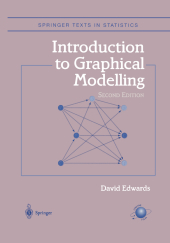 Neuerscheinungen 2012Stand: 2020-01-07 |
Schnellsuche
ISBN/Stichwort/Autor
|
Herderstraße 10
10625 Berlin
Tel.: 030 315 714 16
Fax 030 315 714 14
info@buchspektrum.de |

David Edwards
Introduction to Graphical Modelling
2. Aufl. 2012. xv, 335 S. 4 SW-Abb. 254 mm
Verlag/Jahr: SPRINGER, BERLIN 2012
ISBN: 1-461-26787-0 (1461267870)
Neue ISBN: 978-1-461-26787-4 (9781461267874)
Preis und Lieferzeit: Bitte klicken
A useful introduction to this topic for both students and researchers, with an emphasis on applications and practicalities rather than on a formal development. It is based on the popular software package for graphical modelling, MIM, freely available for downloading from the Internet. Following a description of some of the basic ideas of graphical modelling, subsequent chapters describe particular families of models, including log-linear models, Gaussian models, and models for mixed discrete and continuous variables. Further chapters cover hypothesis testing and model selection. Chapters 7 and 8 are new to this second edition and describe the use of directed, chain, and other graphs, complete with a summary of recent work on causal inference.
´1 Preliminaries.- 1.1 Independence and Conditional Independence.- 1.2 Undirected Graphs.- 1.3 Data, Models, and Graphs.- 1.4 Simpson´s Paradox.- 1.5 Overview of the Book.- 2 Discrete Models.- 2.1 Three-Way Tables.- 2.1.1 Example: Lizard Perching Behaviour.- 2.2 Multi-Way Tables.- 2.2.1 Likelihood Equations.- 2.2.2 Deviance.- 2.2.3 Graphs and Formulae.- 2.2.4 Example: Risk Factors for Coronary Heart Disease.- 2.2.5 Example: Chromosome Mapping.- 2.2.6 Example: University Admissions.- 3 Continuous Models.- 3.1 Graphical Gaussian Models.- 3.1.1 Likelihood.- 3.1.2 Maximum Likelihood Estimation.- 3.1.3 Deviance.- 4 3.1.4 Example: Digoxin Clearance.- 3.1.5 Example: Anxiety and Anger.- 3.1.6 Example: Mathematics Marks.- 3.2 Regression Models.- 3.2.1 Example: Determinants of Bone Mineral Content.- 4 Mixed Models.- 4.1 Hierarchical Interaction Models.- 4.1.1 Models with One Discrete and One Continuous Variable.- 4.1.2 A Model with Two Discrete and Two Continuous Variables.- 4.1.3 Model Formulae.- 4.1.4 Formulae and Graphs.- 4.1.5 Maximum Likelihood Estimation.- 4.1.6 Deviance.- 4.1.7 A Simple Example.- 4.1.8 Example: A Drug Trial Using Mice.- 4.1.9 Example: Rats´ Weights.- 4.1.10 Example: Estrogen and Lipid Metabolism.- 4.2 Breaking Models into Smaller Ones.- 4.3 Mean Linearity.- 4.4 Decomposable Models.- 4.5 CG-Regression Models.- 4.5.1 Example: Health Status Indicators.- 4.5.2 Example: Side Effects of an Antiepileptic Drug.- 4.6 Incomplete Data.- 4.6.1 Assumptions for Missing Data.- 4.6.2 Some Latent Variable Models.- 4.6.3 Example: The Components of a Normal Mixture.- 4.6.4 Example: Mathematics Marks, Revisited.- 4.7 Discriminant Analysis.- 4.7.1 Example: Breast Cancer.- 5 Hypothesis Testing.- 5.1 An Overview.- 5.2 X2-Tests.- 5.3 F-Tests.- 5.4 Exact Conditional Tests.- 5.5 Deviance-Based Tests.- 5.6 Permutation F-Test.- 5.7 Pearson x2-Test.- 5.8 Fisher´s Exact Test.- 5.9 Rank Tests.- 5.10 Wilcoxon Test.- 5.11 Kruskal-Wallis Test.- 5.12 Jonckheere-Terpstra Test.- 5.13 Tests for Variance Homogeneity.- 5.14 Tests for Equality of Means Given Homogeneity.- 5.15 Hotelling´s T2.- 6 Model Selection and Criticism.- 6.1 Stepwise Selection.- 6.1.1 Forward Selection.- 6.1.2 Restricting Selection to Decomposable Models.- 6.1.3 Using F-Tests.- 6.1.4 Coherence.- 6.1.5 Other Variants of Stepwise Selection.- 6.2 The EH-Procedure.- 6.2.1 Example: Estrogen and Lipid Metabolism, Continued.- 6.3 Selection Using Information Criteria.- 6.4 Comparison of the Methods.- 6.5 Box-Cox Transformations.- 6.6 Residual Analysis.- 6.7 Dichotomization.- 7 Directed Graphs and Their Models.- 7.1 Directed Acyclic Graphs.- 7.1.1 Markov Properties of DAGs.- 7.1.2 Modelling with DAGs.- 7.1.3 Example: Side Effects of Neuroleptics.- 7.2 Chain Graphs.- 7.2.1 Markov Properties of Chain Graphs.- 7.2.2 Modelling with Chain Graphs.- 7.2.3 Example: Membership of the "Leading Crowd".- 7.3 Local Independence Graphs.- 7.4 Covariance Graphs.- 7.5 Chain Graphs with Alternative Markov Properties.- 7.6 Reciprocal Graphs.- 8 Causal Inference.- 8.1 Philosophical Aspects.- 8.2 Rubin´s Causal Model.- 8.2.1 Estimating Causal Effects.- 8.2.2 Ignorability.- 8.2.3 Propensity Score.- 8.2.4 Causal Hypothesis Testing.- 8.3 Pearl´s Causal Graphs.- 8.3.1 A Simple Causal model.- 8.3.2 Causal Graphs.- 8.3.3 The Back-Door Criterion.- 8.3.4 The Front-Door Criterion.- 8.4 Discussion.- 8.4.1 Comparison of the Two Approaches.- 8.4.2 Operational Implications.- A The MINI Command Language.- A.1 Introduction.- A.2 Declaring Variables.- A.3 Undirected Models.- A.3.1 Deleting Edges.- A.3.2 Adding Edges.- A.3.3 Other Model-Changing Commands.- A.3.4 Model Properties.- A.4 Block-Recursive Models.- A.4.1 Defining the Block Structure.- A.4.2 Block Mode.- A.4.3 Defining Block-Recursive Models.- A.4.4 Working with Component Models.- A.5 Reading and Manipulating Data.- A.5.1 Reading Casewise Data.- A.5.2 Reading Counts, Me


